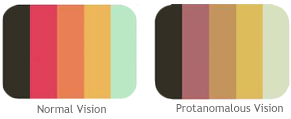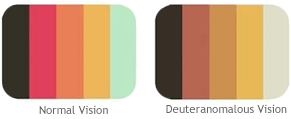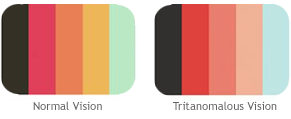Anamalous Trichromacy
Anomalous Trichromacy is the most common category of color blindness. It is an impairment of normal color vision, not a complete loss. This occurs when one of the cones is altered in its spectral sensitivity. It can be red/green or blue/yellow depending on which cone is altered.The ability of anomalous trichromats to distinguish between hues is better than dichromats but still not normal.
There are 3 forms of Anomalous trichromacy:
Protanomaly

Protanomaly is referred to as "red-weakness", an apt description of this form of color deficiency. Any redness seen in a color by a normal observer is seen more weakly by the protanomalous viewer, both in terms of its "coloring power" (saturation, or depth of color) and its brightness.
Red, orange, yellow, and yellow-green appear somewhat shifted in hue ("hue" is just another word for "color") towards green, and all appear paler than they do to the normal observer. The redness component that a normal observer sees in a violet or lavender color is so weakened for the protanomalous observer that he may fail to detect it, and therefore sees only the blue component. Hence, to him the color that normals call "violet" may look only like another shade of blue.
Deuteranomaly

It is a type of anomalous trichromatic vision in which the green-sensitive cones have decreased sensitivity. It is an X-linked trait, affecting about 5% of white males and 0.25% of females in the United States, and is the most common color vision deficiency.
It is an inherited disorder of color vision, caused by a gene located on the X chromosome, in which a person has all three of the retinal pigments in the cones, but the sensivity of the green-sensitive cones is decreased.
Tritanomaly

It is a rare type of anomalous trichromatic vision in which the third, blue-sensitive, cones have decreased sensitivity. Less than about 0.01% of people affected by it. However, it is known that reds and greens are unaffected, and some yellows may be visible on the lower end of the spectrum with this disorder.
What is known about protanomaly and deuteranomaly suggests that tritanomaly is caused by defective S photopigment. It is known that persons affected by this condition have difficulty distinguishing between yellow and blue.
Information
Test Benefits
- Eliminates staff time used administering the test.
- Identify training or oversight opportunities for colorblind employees who present special risks within the organization.
- Faster turnaround on results for recruiters, staffers, and hiring managers.
- Special development and timing on TCV ensures tests are administered correctly.
- Employees can take tests anywhere at anytime.
Take a Test
Test your color vision online now with a test developed by a color vision specialist, Dr. Terrace L. Waggoner.
If you have any questions , please contact us at info@testingcolorvision.com.

